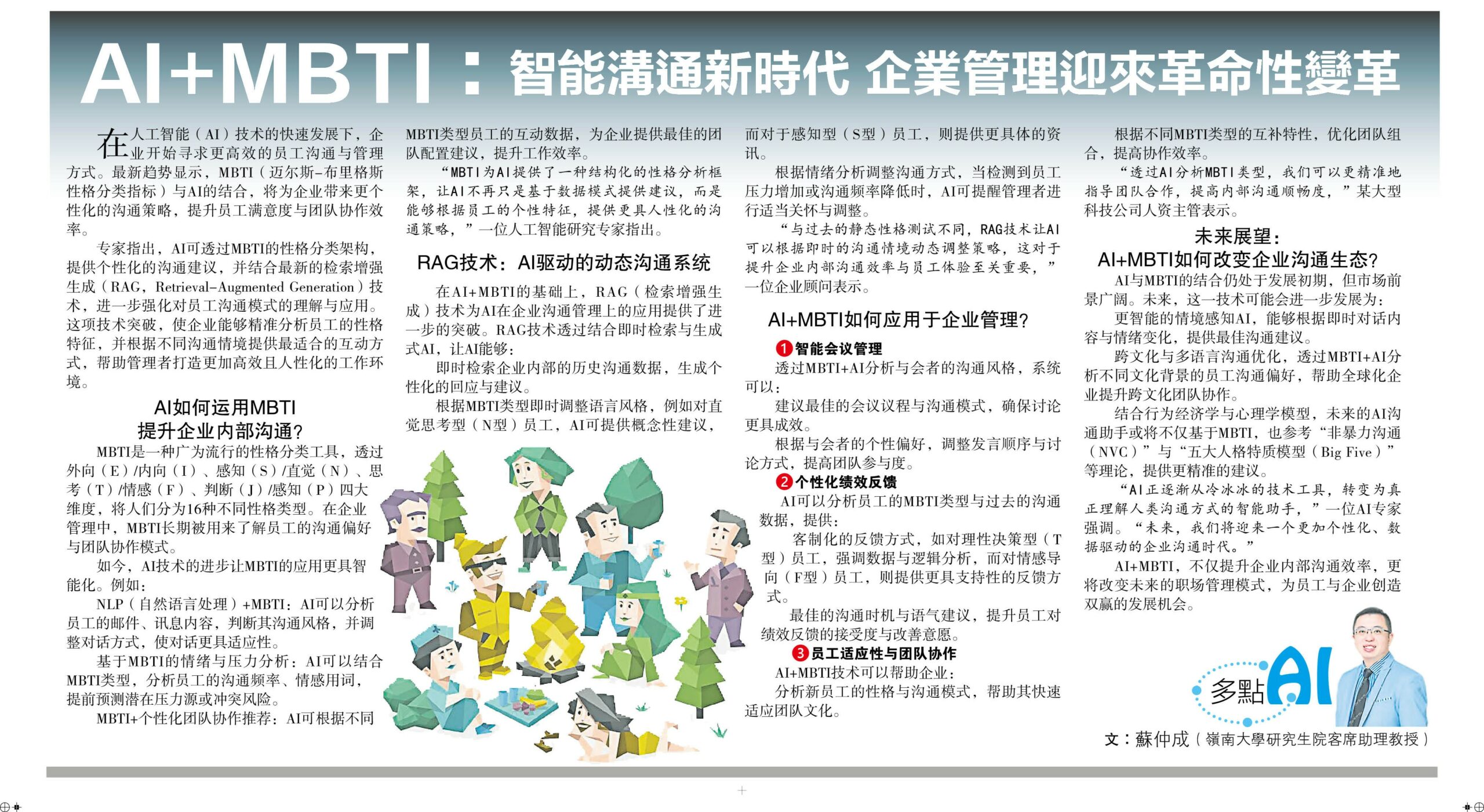AI創業致富證書課程 Kick-Off at Hong Kong Academy of Management
Today’s session at Hong Kong Academy of Management was about showing entrepreneurs and professionals how

Published on Sin Chew Media Corporation Bhd on the 23rd April, 2025, HK01 on the 17th March 2025
With the rapid advancement of Artificial Intelligence (AI) technology, businesses are seeking more efficient methods for employee communication and management. The latest trend shows that integrating MBTI (Myers-Briggs Type Indicator) with AI is set to bring more personalized communication strategies, enhancing employee satisfaction and team collaboration efficiency.
Experts point out that AI can provide personalized communication suggestions through MBTI personality frameworks and, combined with Retrieval-Augmented Generation (RAG) technology, can further strengthen the understanding and application of employee communication patterns. This technological breakthrough enables businesses to precisely analyze employee personality traits and offer optimal interaction methods tailored to various communication scenarios, helping managers create a more efficient and humane workplace.
MBTI is a widely popular personality classification tool, categorizing people into 16 distinct personality types based on four dimensions: Extraversion (E)/Introversion (I), Sensing (S)/Intuition (N), Thinking (T)/Feeling (F), and Judging (J)/Perceiving (P). In business management, MBTI has long been utilized to understand employee communication preferences and teamwork styles.
Today, advancements in AI technology have made the application of MBTI more intelligent. For example:
“MBTI provides AI with a structured framework for personality analysis, allowing AI not just to offer recommendations based on data patterns but to deliver communication strategies that consider individual personality traits,” says an AI research expert.
Building upon AI+MBTI, Retrieval-Augmented Generation (RAG) technology offers further advancements in enterprise communication management. By integrating real-time retrieval with generative AI, RAG enables AI to:
“Unlike traditional static personality tests, RAG technology allows AI to dynamically adjust communication strategies according to real-time situations, significantly enhancing internal communication efficiency and employee experience,” a business consultant states.
By analyzing attendees’ communication styles through MBTI+AI, systems can:
AI can analyze MBTI types and historical communication data of employees to offer:
AI+MBTI technology helps businesses:
“Through AI-driven MBTI analysis, we can precisely guide team cooperation and enhance internal communication smoothness,” notes an HR executive from a major tech company.
The integration of AI and MBTI is still in its early stages, but its market potential is vast. Future developments may include:
“AI is gradually evolving from a cold, technical tool into an intelligent assistant that truly understands human communication,” emphasizes an AI expert. “In the future, we will enter a more personalized, data-driven era of business communication.”
AI+MBTI not only enhances internal corporate communication efficiency but also revolutionizes future workplace management, creating win-win development opportunities for both employees and organizations.
AI+MBTI:智能溝通新時代 企業管理迎來革命性變革
在人工智能(AI)技術的快速發展下,企業開始尋求更高效的員工溝通與管理方式。最新趨勢顯示,MBTI(邁爾斯-布里格斯性格分類指標)與AI的結合,將為企業帶來更個性化的溝通策略,提升員工滿意度與團隊協作效率。
專家指出,AI可透過MBTI的性格分類架構,提供個性化的溝通建議,並結合最新的檢索增強生成(RAG,Retrieval-Augmented Generation)技術,進一步強化對員工溝通模式的理解與應用。這項技術突破,使企業能夠精準分析員工的性格特徵,並根據不同溝通情境提供最適合的互動方式,幫助管理者打造更加高效且人性化的工作環境。
AI如何運用MBTI提升企業內部溝通?
MBTI是一種廣為流行的性格分類工具,透過外向(E)/內向(I)、感知(S)/直覺(N)、思考(T)/情感(F)、判斷(J)/感知(P)四大維度,將人們分為16種不同性格類型。在企業管理中,MBTI長期被用來了解員工的溝通偏好與團隊協作模式。
如今,AI技術的進步讓MBTI的應用更具智能化。例如:
NLP(自然語言處理)+MBTI:AI可以分析員工的郵件、訊息內容,判斷其溝通風格,並調整對話方式,使對話更具適應性。
基於MBTI的情緒與壓力分析:AI可以結合MBTI類型,分析員工的溝通頻率、情感用詞,提前預測潛在壓力源或衝突風險。
MBTI+個性化團隊協作推薦:AI可根據不同MBTI類型員工的互動數據,為企業提供最佳的團隊配置建議,提升工作效率。
「MBTI為AI提供了一種結構化的性格分析框架,讓AI不再只是基於數據模式提供建議,而是能夠根據員工的個性特徵,提供更具人性化的溝通策略,」一位人工智能研究專家指出。
RAG技術:AI驅動的動態溝通系統
在AI+MBTI的基礎上,RAG(檢索增強生成)技術為AI在企業溝通管理上的應用提供了進一步的突破。RAG技術透過結合即時檢索與生成式AI,讓AI能夠:
即時檢索企業內部的歷史溝通數據,生成個性化的回應與建議。
根據MBTI類型即時調整語言風格,例如對直覺思考型(N型)員工,AI可提供概念性建議,而對於感知型(S型)員工,則提供更具體的資訊。
根據情緒分析調整溝通方式,當檢測到員工壓力增加或溝通頻率降低時,AI可提醒管理者進行適當關懷與調整。
“與過去的靜態性格測試不同,RAG技術讓AI可以根據即時的溝通情境動態調整策略,這對於提升企業內部溝通效率與員工體驗至關重要,” 一位企業顧問表示。
AI+MBTI如何應用於企業管理?
透過MBTI+AI分析與會者的溝通風格,系統可以:
建議最佳的會議議程與溝通模式,確保討論更具成效。
根據與會者的個性偏好,調整發言順序與討論方式,提高團隊參與度。
AI可以分析員工的MBTI類型與過去的溝通數據,提供:
客製化的反饋方式,如對理性決策型(T型)員工,強調數據與邏輯分析,而對情感導向(F型)員工,則提供更具支持性的反饋方式。
最佳的溝通時機與語氣建議,提升員工對績效反饋的接受度與改善意願。
AI+MBTI技術可以幫助企業:
分析新員工的性格與溝通模式,幫助其快速適應團隊文化。
根據不同MBTI類型的互補特性,優化團隊組合,提高協作效率。
“透過AI分析MBTI類型,我們可以更精準地指導團隊合作,提高內部溝通順暢度,” 某大型科技公司人資主管表示。
未來展望:AI+MBTI如何改變企業溝通生態?
AI與MBTI的結合仍處於發展初期,但市場前景廣闊。未來,這一技術可能會進一步發展為:
更智能的情境感知AI,能夠根據即時對話內容與情緒變化,提供最佳溝通建議。
跨文化與多語言溝通優化,透過MBTI+AI分析不同文化背景的員工溝通偏好,幫助全球化企業提升跨文化團隊協作。
結合行為經濟學與心理學模型,未來的AI溝通助手或將不僅基於MBTI,也參考「非暴力溝通(NVC)」與「五大人格特質模型(Big Five)」等理論,提供更精準的建議。
“AI正逐漸從冷冰冰的技術工具,轉變為真正理解人類溝通方式的智能助手,” 一位AI專家強調。”未來,我們將迎來一個更加個性化、數據驅動的企業溝通時代。”
AI+MBTI,不僅提升企業內部溝通效率,更將改變未來的職場管理模式,為員工與企業創造雙贏的發展機會。
Today’s session at Hong Kong Academy of Management was about showing entrepreneurs and professionals how
在人工智慧技術飛速發展的當下,算力基建、智慧財產權保護與開源共用正成為創新領域的焦點議題。近日,筆者以香港浸會大學專利顧問委員會成員的身份,見證於北京舉行的華為2025年創新和智慧財產權論壇,親身感受這場以“開放驅動創新”為主題的思想碰撞。論壇上,華為發佈了第六屆“十大發明”評選結果,涵蓋計算、作業系統、存儲等面向未來的關鍵技術領域。其中最引人注目者,莫過於名列首位的“Scale-up超大規模超節點算力平臺”——一套超級算力系統,被譽為人工智慧時代的新型基礎設施。本文將結合論壇見聞和筆者實務經驗,觀察該超級算力在AI時代的基建角色,探討“開源共用”與“智慧財產權保護”對創新的雙重意義,並反思香港在創新基建、產學研轉化、專利文化等方面的瓶頸與出路。 超級算力集群:AI時代的基建底座 這款被華為評為年度十大發明之首的Scale-up超大規模超節點算力平臺,實質上是由眾多AI處理器組成的單一邏輯超級電腦。隨著AI模型規模指數級增長,訓練這些模型所需的算力和資料輸送量呈爆炸式上升。傳統的伺服器堆疊模式面對超大型AI任務時,往往出現“ 集群越大、有效算力利用率反而越低,訓練中斷越頻繁”的窘境。華為針對此痛點創新出“超節點”系統架構,具備資源池化、線性擴展和高可靠性等特性:通過統一高速協定和共用記憶體編址,打通計算與存儲單元的高頻寬低時延互聯,使有效算力可隨節點規模近乎線性增長,同時大幅提升集群穩定性。華為輪值董事長徐直軍強調:“算力是——而且將繼續是——AI的關鍵”。基於對這一點的共識,華為推出了新一代Atlas系列超節點產品,其中Atlas 950 SuperPoD即對應此次的Scale-up超級算力。該平臺面向超大型AI訓練任務,從基礎器件、協定演算法到光電互聯均實現了系統級創新。例如,它採用正交架構設計實現零線纜的電氣互連,搭配全液冷散熱與浮動盲插技術確保不滲漏,同時首創UB-Mesh遞迴直連拓撲,支持單板內、板間、機架間NPU全互聯,以64卡為模組靈活擴展,最大可支援8192顆昇騰AI處理器無收斂互聯。換言之,上千顆AI晶片可彙聚成“一個大腦”協同運算,真正消除超大規模訓練的瓶頸。 從實踐看,超級算力已不僅是實驗室概念,而成為產業AI生態的基礎底座。華為透露,截至目前其上一代Atlas 900系列超節點系統已累計部署超過300套,服務於互聯網、金融、電信、電力、製造等行業的20多家客戶。在人工智慧時代,類似Atlas 950這樣的本地智算樞紐,相當於數字經濟的高速公路與電力網絡:為產業生態提供共用的算力資源,降低創新應用部署門檻,有力支撐從雲服務到垂直行業落地的AI解決方案。尤其對中國而言,在先進晶片供給受限的背景下,華為選擇利用現有制程自研超大規模計算平臺,以系統工程突破彌補晶片性能不足,體現出以基建思維佈局AI長遠發展的戰略定力。 “開放共用”與“智慧財產權”:雙軌驅動創新的辯證 本屆論壇傳遞出一個明確訊息:開源合作和智慧財產權保護並非對立,而是創新發展的雙引擎,需同步推進、制度協調。華為首席法務官宋柳平在會上表示:“開放創新是推動社會發展和技術進步的重要力量,也是華為的DNA。華為一直在踐行‘開放’的理念,用開放驅動創新。同時,華為注重自有智慧財產權的保護,也尊重他人的智慧財產權,包括專利、商標、版權和商業秘密等。”簡言之,一方面積極參與開源與共用,另一方面嚴格保障智慧財產權,兩條路並行不悖。華為近年來在專利研發和佈局上不遺餘力。2024年華為專利授權收入約6.3億美元,同時其歷年累計支付的專利許可費是自身許可收入的三倍之多。根據世界智慧財產權組織統計,華為2024年通過PCT公開的國際專利申請達6600件,自2014年以來連續位居全球首位。僅2024年一年,華為新公開專利就達3.7萬件,創下歷史新高。強大的專利庫讓華為在5G、Wi-Fi、視頻編碼等領域建立了廣泛的授權生態:截至2024年底,全球已有超過27億台5G設備、12億台消費電子設備和32億台多媒體設備獲得華為專利授權,全球500強企業中有48直接或間接獲得華為的授權許可。 另一方面,華為在開源開放方面同樣投入巨大資源。其副總裁、智慧財產權部部長樊志勇指出,華為透過“軟體開源、硬體開放、專利申請、標準貢獻與學術論文等多種形式”推動技術開放。2024年華為向標準組織新提交技術提案超1萬篇,發表學術論文逾1000篇;在開源社區方面,主導或參與了多個大型專案,例如OpenHarmony開源作業系統社區已有超過8100名共建者;openEuler開源OS發行版本累計裝機量已突破1000萬套;並將昇騰AI基礎軟體棧全面開源,包括CANN計算架構和MindSpore深度學習框架,並優先適配主流開源社區如PyTorch、vLLM等。 由此可見,“智慧財產權保護”保障了創新者的投入回報和商業動力,而“開源共用”則能彙聚眾智加速技術成熟與應用擴散。兩者並非水火不容,關鍵在於尋求制度性的平衡與協同。正如香港大學鄧希煒教授所言,一個強健、開放且受國際信賴的專利體系是創新引擎運轉不可或缺的條件。 全球範圍內,“開源”與“封閉”的博弈亦在演變。NVIDIA以CUDA軟體平臺構建封閉生態,形成極高的市場壁壘與利潤迴圈,但OpenAI從開源轉向封閉的過程亦引發反思。當Meta等公司以Llama開源模型崛起,開源生態再次展現強勁生命力。這些案例共同說明:唯有平衡專利保護與開源合作,才能讓科技創新在競爭與共榮中持續演進。 香港創新生態的瓶頸與建議
AiX Society is thrilled to congratulate our valued partner, Midas Analytics, for winning the prestigious
HKOEA Consultancy
Licence No. 59684
© 2025 Artificial Intellegence Application Research Society. All rights reserved
by Originals Group – Hong Kong, Malaysia, GBA